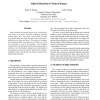Free Online Productivity Tools
i2Speak
i2Symbol
i2OCR
iTex2Img
iWeb2Print
iWeb2Shot
i2Type
iPdf2Split
iPdf2Merge
i2Bopomofo
i2Arabic
i2Style
i2Image
i2PDF
iLatex2Rtf
Sci2ools
CVPR
2000
IEEE
2000
IEEE
Alpha Estimation in Natural Images
Many boundaries between objects in the world project onto curves in an image. However, boundaries involving natural objects (e.g., trees, hair, water, smoke) are often unworkable under this model because many pixels receive light from more than one object. We propose a technique for estimating alpha, the proportion in which two colors mix to produce a color at the boundary. The technique extends bluescreen mattingtobackgrounds that have almost arbitrary color distributions, though coarse knowledge of the boundary’s location is required. Results show a number of different objects moved from one image to another while maintaining naturalism.
Related Content
| Added | 30 Jul 2010 |
| Updated | 30 Jul 2010 |
| Type | Conference |
| Year | 2000 |
| Where | CVPR |
| Authors | Mark A. Ruzon, Carlo Tomasi |
Comments (0)

